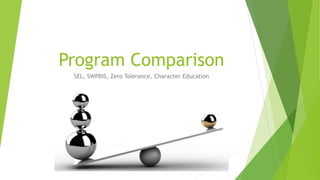
Sel and other programs
- 1. Program Comparison SEL, SWPBIS, Zero Tolerance, Character Education
- 2. What Programs will we be comparing? The basics
- 3. Zero-Tolerance Primary Aim: Short term management of student behavior; created in an attempt to make schools safer Methods: Behavior problems corrected immediately and swiftly; relies primarily on punitive techniques Strengths: Behavior corrected in the short term Weaknesses: Change in behavior does not extend beyond the school or to other environments Research: APA suggests this method is ineffective and needs to be replaced or reformed
- 4. Non-SEL Character Education Programs These are either official programs or those presented by a school counselor with the aim of improving student behavior and/or character Explicit teaching of “character traits” (e.g. courage, kindness, respect, etc.) Anecdotally, I have not seen this to be effective, but have not looked into the research
- 5. Schoolwide Positive Behavioral Interventions and Supports (SWPBIS) Primary Aim: The adult management of student behavior using a positive rather than punitive approach (more focused on short term) Methods: Direct teaching of behavioral expectations Positive reinforcement of appropriate behavior (e.g. tangible rewards, verbal praise, etc.) System for responding to inappropriate behavior Extensive use of research and data: Use research-validated practices Collect data for decision making (e.g. Suspensions data, office referrals, academic outcomes, etc)
- 6. Schoolwide Positive Behavioral Interventions and Supports (SWPBIS) Strengths: evidenced-based targeted for intervention ongoing use of data values prevention over correction clear teacher-directed techniques for managing student behavior Good for chaotic classrooms Weaknesses: no explicit attempt to develop cognitions, emotions and behaviors of self-discipline Methods may not lead to lasting change in student behavior (since behavior tends to stop once consequences no longer present)
- 7. Social and Emotional Learning (SEL) Programs Primary Aim: The long-term development of social and emotional competencies so students can govern themselves Methods: Explicit instruction of SEL skills (the five-competencies) Promotion of positive school climate Warm and supportive relationships Structure of support
- 8. Social and Emotional Learning (SEL) Programs Strengths: Evidence-based Develops cognitions, emotions, and behaviors of self-discipline Values prevention over correction Associated with a variety of positive outcomes (improved grades, behavior, etc.) Weaknesses: Lack of explicit behavioral management techniques Few SEL programs have built-in strategies that guide teachers in deescalating challenging behaviors
- 12. How SEL and SWPBIS Can Work Together
- 13. How SEL and SWPBIS Can Work Together Use reinforcement (SWPBIS) and discussion/reflection (SEL) Use external rewards sparingly, as “a bridge” Especially in regards to teamwork Rewarding the underlying emotions/cognitions Caution: Potential harms to intrinsic motivation if used incorrectly For negative consequences, follow up with reflection Ex: Student puts student in time-out then follows-up with the student by talking about his/her behavior and how to manage similar experiences differently For positive reinforcement, follow up with discussion Ex: Give a student a token for helping a peer, but then discuss with him/her why that action was valuable outside of the reinforcement (e.g. made the peer feel happy)
- 15. Discussion Questions Do you agree or disagree with the research? Why? Which method do you tend to agree with? (We may be a biased sample! :D ) Is there a time and place for zero-tolerance or never? If you have worked in a school or similar environment, have you seen any of these programs in action? What did it look like? Do you think that SEL and SWPBIS are compatible?
- 16. References APA Zero Tolerance Task Force (2008) - Are Zero Tolerance Policies Effective in Schools? Joseph A. Durlak - Handbook of Social and Emotional Learning (Chapter 30)